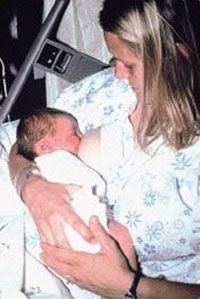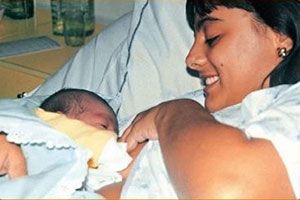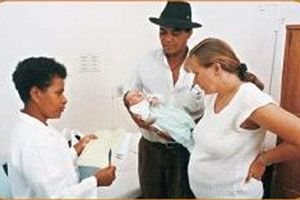The childbirth

Foto:
Labour signs
Some signs indicate the onset of the labour:
Release of the mucous plug, which is a type of elastic mucous closing the opening of the womb and protects it against bacteria and fungi. Sometimes the release of the mucous plug may happen some days before true labour;
Pain felt in the back that moves to the low abdomen;
Contractions, which start slowly, the abdomen remains rigid for 30 seconds, and then relaxes. These contractions usually come every thirty minutes.
The family shall plan their trip to the hospital according to the distance from their home to hospital. If it is very close, they can wait till the contractions occur every 10 minutes.
Attention: In case the pregnant woman does not feel crumps but begins to discharge a big amount of water – going down her legs – this is a sign of rupture of the amniotic sac. Then she has to go immediately to hospital.
Labour

Foto:
The childbirth is the celebration of life and of hope. It is a miracle of God that has taken place.
Everything has to be done so that the birth of the baby is natural, with almost no risk or suffering for the mother and the baby. In a very well assisted labour, the mother and the baby are to be treated with respect, tenderness and attention. They are to be accommodated in a room with good hygiene condition and assisted by qualified health providers to prevent or to solve any problems that may arise.
If possible, it is recommended that the father attend the labour and be present soon after it has occurred. This denotes his own commitment with the baby and it helps the connection between them.
The Brazilian Law no 11.108 of 7th April 2005 establish that the health services of the SUS – The Sole Public Health System - of its own network or a convened one, must allow the presence of a companion with the pregnant woman during pre-labour, labour and after the labour. Such companion shall be appointed by the pregnant woman.
Joint accommodation

Foto:
The baby shall be soon placed at the breast to suck, soon after the child is born. Thus the child receives the colostrums and will smell, feel the heat and the voice of the mother. When doing so the baby begins to get used, in a milder way, to the life out of the mother’s womb.
If the mother and the baby are well they may be accommodated in a joint room, that is, the baby should be put very close to the mother in the same room. This is a right ensured by the Children and Adolescents Statute.
In the joint room, the baby may be fed whenever he/she needs and will be cuddled by the parents. When the baby is close to the mother she can always watch whether there is something wrong with the child.
“A woman in childbirth suffers, because her time has come; but when she has given birth to the child she forgets the suffering in her joy that a human being has been born into the world.” Joh 16:21
Watching the newly born baby

Foto:
When the baby is born the skin is smooth and covered by a layer of fat which protected him/her in the womb.
Some babies come with thin and long hairs on their back, ears and face. In general they disappear within a week.
The baby may have some small red spots in the nose, which look like small pimples. Those spots shall never be squeezed because they may get inflamed. They shall disappear within one or two months.

Foto:
The baby’s head is big if compared to the body. The skull bones haven't yet grown together and that is why babies have fontanel (s).
Some of the babies may be born with some bones over the others. This is to allow the baby's relatively big head to move down to the narrow birth canal. It is not necessary to use caps to protect the fontanel. The fontanel closes while the baby grows.
In the normal labour the baby may show a little swollen scalp. This is related to the birth. The baby’s head pressure to dilate the womb wall. In a few days the head resumes to its normal shape.
The baby may also be born with the face swollen, with stains or birth signals. Some babies may have a stain on the buttock, which shall also disappear after a while.

Foto:
Either the boys or the girls may be born with the mammary gland (teats) swollen. This is caused by the transmission of the mother’s hormones into the baby’s body through the belly button. The mammary glands shall not be squeezed. This may wound the baby and cause them to be inflamed. This swollenness will soon disappear.
The baby’s tummy is high and big. When the baby breathes, the tummy goes up and down. The belly button is thick, whitish and humid. The baby’s arms and legs are short compared to his / her body.
The boys may be born with the testicles big and full of liquid; these also tend to diminish in the first months. They also may be born with the testicles withered because these have not come down from the abdomen yet.
The girls may be born with their external genitals (the long inner lips) swollen and presenting some white discharge or even a dark blood discharge that goes out from the vagina. This is also caused by the passage of the mother’s hormones into the baby’s body through the belly button. The mother does not have to worry with that because it shall disappear in a few days.
The presence of a companion only is not allowed in case of a high risk labour.
Breastfeeding: Colostrum

Foto:
When the baby is put to suck at the breast soon after he/ she is born, this does him/ her and the mum good because the milk comes down earlier and the connection between the child and the mother tends to be strong. When the baby sucks the breast, this helps the placenta to be discharged sooner and the mother consequently looses less blood and her womb returns faster to its normal size. Therefore, breastfeeding is very important to the baby and to the mother.
Breastfeeding is an act that needs to be learnt by the mother and by the baby. That is why it is important the mother knows she might need help from the health providers to learn how to breastfeed. All effort to promote breastfeeding is blessed!
Attention: The mother shall breastfeed only her baby. She should never give her baby to another mother to be breastfed. Some diseases may be transmitted to the baby through the mother's milk.

Foto:
In the first days the baby sucks the colostrum, which is a yellow transparent milk, much thicker, protein and mineral salt enriched, which contains defences against diseases. Besides being a health source, the colostrum helps in the first faecal excretion of a newborn. This faecal excretion is called meconium, dark and sticky like asphalt tar.
Some women, between the second and the fifth day after the delivery, feel their breasts are heavier, a little sore and slightly hot. This is normal. It is very important the mother keeps on breastfeeding, putting the baby in the right mouth sucking position (page 112). Thus the uneasiness disappears faster and breastfeeding occurs normally.
As time goes by, the woman’s body itself changes the milk according to the baby’s need. The mother’s milk will have other nutrients for the baby to grow healthy. Therefore, the maternal milk is always fit for the baby’s age.
Low weight babies

Foto:
Some babies may be born weighing less than two and a half kilos (2.500 g). They need to be in hospital for a longer time to receive special care.
The ideal situation would be that the mother could stay with the baby during this phase, or that she or the father would visit the child whenever possible.
In those visits, it is important to breastfeed the baby and to have the baby’s body close to the mother so she/he can feel warm as well if he/she were still in the mother’s womb, receiving the touch on the skin and feeling the smell and the movements of the mother. The father may also hold the baby close to his body to strengthen his connection with the baby and to help the mother.
The low weight baby shall be fed more times per day and also at night. If the child sleeps for 3 hours, he/she shall be gently awakened to be breastfed. Doing so will help the baby to gain weight faster.
Health Card

Foto:
After the birth the child is entitled to receive the Child Health’s Card free at the hospital. All data for the follow up of the child shall be written down such as:
• Birth description;
• Weight – growth follow-up;
• Vaccines;
• Diseases the child has had;
There is a card for the boys and a card for the girls because they gain weight in different ways.
Every child must have only one Health Card. It has to be kept by the parents so they follow up the growth of their child. It is a very important document so it is required that they are instructed to keep it in very good care.
Vaccines
The baby is born with few defences against some diseases. Therefore the child needs to be protected by vaccines. Still in the maternity the baby shall take:
• The first dose of vaccine against Hepatitis B;
• One dose of BCG against the serious types of Tuberculosis.
Leader, note the example: A newborn baby on 20th January 2006 has had written down the following on his/her Health Card:

In general the health providers note down in pencil the date for the next dose of the same vaccine.
If the BCG vaccine is not taken at the maternity, the baby shall be taken to the health service unit within 28 days as of the child’s birth date.
Danger signs in the newborn baby
Soon after they are born, some babies may show some health problems which, if discovered on time, will save everybody from a great deal of suffering.
Attention: While still at the maternity, the mother should request assistance when the baby shows some of the following signs:
Refuses to get fed;
Does not have faecal excretion;
If the rectum hole is closed;
Low body temperature;
Does not urinate;
Fever;
Lots of salivation;
Purple lips, feet and hands;
Breathing difficulty;
Swollen tummy;
Pale, yellow skin colour (jaundice);
Not responsive, too week;
Guthrie test
The Guthrie Test is made with blood drops collected from the heel of the newborn baby, as of the child’s third day of life and after he/she has been breastfed. The ideal thing to do is that the collect is made between the third and the seventh day of the birth. The Guthrie Test detects diseases, which when early treated, avoid serious problems for the baby.
If the blood test is not collected at the hospital, instruct the mother to do the test at the Health Service Unit..
Birth Statement

Foto:
The Birth Statement is a document with data about the parents and the child delivered by the hospital to the parents. With this statement in hand the parents shall register the birth of the child at the Register of Birth and obtain the Birth Certificate.
According to the Brazilian Law no 9.534 of 10th December, 1997, the family has the right to make the registration of the birth and obtain a free Birth Certificate.
The mother who has paid the Social Security contribution either as a self- employed or a registered employee is entitled to the Maternity Leave. This Leave is of 120 days, in Brazil, counted as of the time she leaves the job and it is designed for her to recover from the childbirth, to breastfeed and to take good care of the baby.
The father that works as an employee, in Brazil, has a five-day leave after the child birth to register the birth of the child and to help the mother in the first baby cares as well as to support her in the beginning of breastfeeding.
Leader, tell the pregnant woman about the importance of the Birth Certificate and remind her that this registration has to be made as soon as possible.
The postnatal period
The period after birth is called puerperium or postnatal period.
The mother may take a shower everyday and wash her hair already on the delivery day.
After the childbirth the mother will have a vaginal discharge similar to the menstruation, which will cease little by little. It is important to do the hygiene. If this discharge increases, it will produce bad odour or a secretion with pus then she has to consult a doctor because this may be a sign of infection.
In the puerperium the intestines tend to work slower and accumulate gases. The mother should move, watch for her food and drink a lot of liquid. She should not leave the hospital if she has problems to urinate or defecate.
At the time of being released from hospital she should appoint another time to return to do the check. It is important that the mother returns for this consultation because it is at that time the doctor checks if everything is all right with her health.
Leader, remind the mother to request the doctor to prescribe the iron. The mother should take this medication until the child reaches the age of 3 months.
Suggestion of task for this qualification stage
Visit the Health Service and answer the questions of pages 88 and 89 for the pregnant woman you are following..



